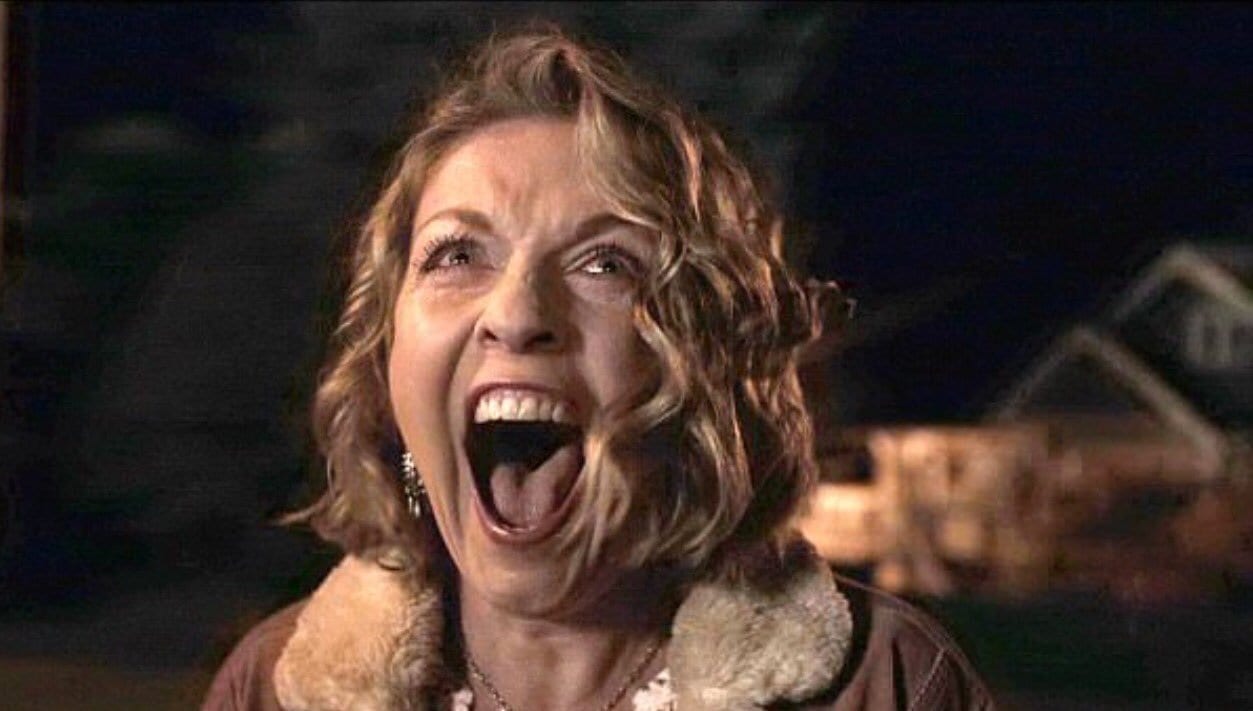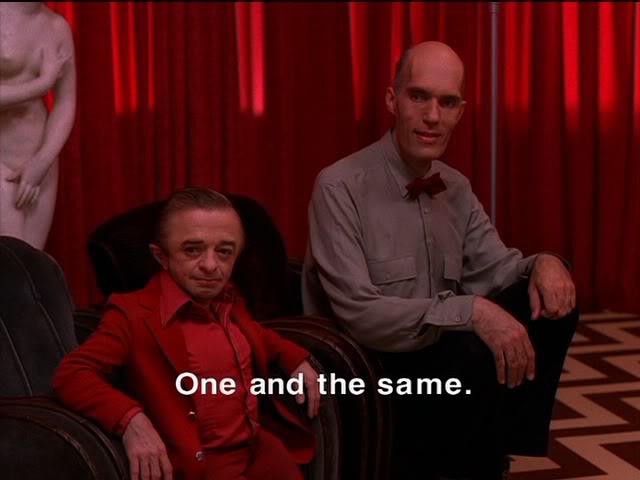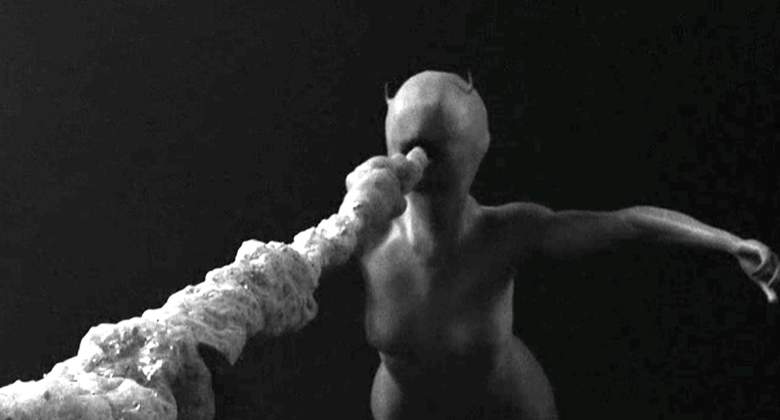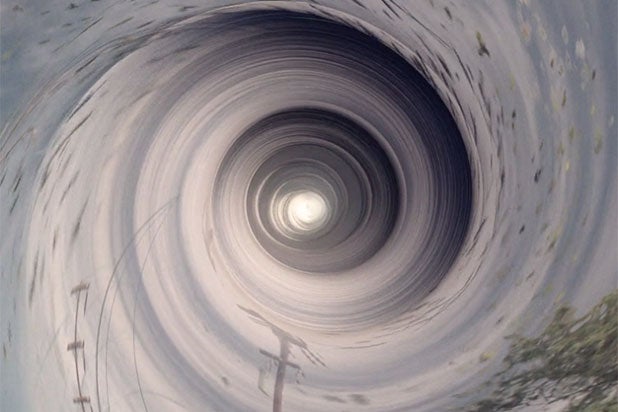riverrun, past Eve and Adam’s, from swerve of shore to bend of bay, brings us by a commodious vicus of recirculation back to Howth Castle and Environs.
(beginning of Finnegans Wake, by James Joyce)
It began 30 years ago with a river carrying the corpse of a young woman wrapped in plastic to the shores of a lake in the town of Twin Peaks. Or did it? This journey, which ostensibly began in the 1990s and continued again in the 2010s, might reveal only the tip of a vast iceberg. What if the bulk of Twin Peaks’ mythological body lies dormant under the surface, displacing a large portion of the space/time ocean? Dreams of many sorts have nourished this quest, re-envisioning our reality through a lens of mystery, romanticism, and surreal occurrences. Various literary works have helped to form its path, from Homer’s Odyssey to Dante’s Divine Comedy and Valmiki’s Ramayana, among others.
In Twin Peaks’ most recent incarnation, the writings of the modern author, James Joyce, have been elevated to a similar mythological level as those of the aforementioned works. Ulysses, Joyce’s retelling of the Odyssey in the context of early 20th century Dublin, bears striking similarities to the narrative design of The Return (discussed in my forthcoming book). Upon closer scrutiny, Finnegans Wake (1939), Joyce’s final novel, is equally worthy of consideration in this regard.

Known as an intimidating, impenetrable, and almost unintelligible web, Joyce’s dream-saga “is a mighty allegory of the fall and resurrection of mankind” whose “mechanics resemble those of a dream” in which “all time occurs simultaneously” (A Skeleton Key to Finnegans Wake, Joseph Campbell). The links one can establish between Finnegans Wake and The Return are numerous, and it may be argued that Joyce’s work served a major role in providing the scaffolding for the story contained in The Return. The complex manner in which the plot of Finnegans Wake unfolds, at times tending towards narrative rupture, mirrors the intricate structure of season 3. Both works require an active reader/viewer ready to put the scrambled pieces of the puzzle together in order to fully appreciate the message. The philosopher Schopenhauer’s image of the world resonates with this: “It is a vast dream, dreamed by a single being, but in such a way that all the dream characters dream too. Thus everything interlocks and harmonizes with everything else.” (On an Apparent Intention in the Fate of the Individual).
The prologue of Joyce’s tale describes Tim Finnegan, an Irish hod carrier, a free mason, really, who when drunk falls off a ladder to his death (echoing Adam’s fall from grace, Humpty Dumpty, or the Cosmic Egg). During the wake, Finnegan is revived by a splash of whiskey and returns to life. He thus becomes a hero-god of sorts, an omnipresence that symbolizes the entirety of humankind. Reality is the return of his sleep, and if he wakes, “the stage is overturned and doomsday arrives.” (Campbell). Echoing this tale of origins, it is important to note the recurrence of the ladder motif in both The Return and Mark Frost’s The Secret History of Twin Peaks.


Finnegans Wake takes place within the confines of enlightenment thinker Giambattista Vico’s cyclical concept in which history passes through four phases, the latter phase of which, much like current times, is characterized by chaos, individualism, and sterility. This is reminiscent of David Lynch’s belief in the “Kali Yuga” age, a concept found in Hindu philosophy, and in which Lynch believes we currently live. It is a dark period of evil, as described by Janey-E in part 5 of The Return.

According to Vico, this age “is terminated by a thunderclap, which terrifies and reawakens mankind to the claims of the supernatural, and thus starts the cycle rolling again with a return to primeval theocracy.” (Campbell). The cyclical aspect of The Return issues in part from this philosophical idea, and the thunderclap in question might well be Carrie’s shriek at the end of part 18, which blows the electrical circuits in the Palmer household.

There are echoes of The Egyptian Book of the Dead throughout Finnegans Wake, and the potential influence of this book on The Return (along with its Asian counterpart, The Bardo Thodol, or The Tibetan Book of the Dead) seems apparent. In it, “One follows the journey of a soul through a dreamlike landscape to the Throne of the Lord of the Dead.” (Campbell). It is difficult to overlook the similarities in that description with the focus in season 3, the entire story of which “may be regarded as something drawn out of the subsoil of the soul.” (Campbell).

Parallels between Finnegans Wake and The Return continue in the character of Humphrey Chimpden Earwicker (HCE), Finnegan’s successor, who dominates the rest of the novel. A tavern keeper in Dublin, Earwicker has been caught peeping at or exhibiting himself to girls in Phoenix Park, Dublin’s equivalent of the Garden of Eden. This original sin led to disgrace, creating HCE’s own version of the Fall. Earwicker is also troubled by desires for his daughter Isabel, who is a reincarnation of his wife. At one point, HCE declares: “I reveal thus my deep-sea daughter which was borne up proudly out of my dreams, unclothed, when I was pillowed in my prime”. One can read both a reference relating to Venus/Aphrodite emerging from the waves (note the various statues of Venus in the Lodges), and to the naked Laura wrapped in plastic.
Anna Livia Plurabelle/ALP, Earwicker/HCE’s wife, is a manifestation of the fruitful principle in the world. She is symbolic of Eve, Isis, Iseult, a river, and a mother hen. Their twin sons, “called in their symbolic aspect Shem and Shaun, and in the domestic aspect Jerry and Kevin” (Campbell), represent a battle polarity present throughout history. Shem, the introverted poet, is associated with the biblical Cain, and Shaun, the policeman of the planet, with brother Abel. Shaun, “while winning of the skirmishes” with his brother, “loses the eternal city.” (Campbell). “HCE, the father of the pair, represents the unity from which their polarity springs.” (Campbell).
Earwicker’s equivalent in Twin Peaks is Dale Cooper, trapped in the Red Room (the Garden of Eden, the Temenos I’ve described in my book Unwrapping the Plastic), whose fall through water/space in part 2 (“non-exist-ent!”) leads to his “descent” into the material world[1], in which he becomes split into polar opposites: his sons Shem (Mr. C, the mother’s pet) and Shaun (Dougie, the father’s pet).

Beyond Earwicker, it could be argued that Cooper is also a manifestation of Finnegan (fine-again) himself, the All-Father. Joyce explains that “It is all one and the same. Finnegan’s form is that of the landscape”.

Just as Finnegan’s story is the prologue to the book, the opening credits of The Return hide Cooper’s form (the archetypal Form of all forms) in the very landscape of Twin Peaks. He too is a gigantic presence beneath and within reality (the mountains) which, mixed with the movement of the river (a manifestation of his wife, ALP), sets the world in motion, towards Howth Castle (by the River Liffey, in Dublin). And where does The Return begin? In the Fireman’s palace/castle, with an exchange between the Fireman and Cooper.

Cooper is the equivalent of HCE/Earwicker, and Dougie corresponds to Shaun, while Mr. C is a match for Shem. Who, then represents ALP and daughter Isabel? Concerning ALP, Cooper’s is not the only form discernible behind the reality of a landscape. When Albert hands a picture of Mount Rushmore to Gordon Cole, one can recognize Cooper’s face in the clouds, as well as that of Diane. She is meant to represent Cooper’s version of Eve in the story, and their sexual relations in part 18 resonate with the notion of original sin. This moment echoes the intercourse between HCE and ALP that takes place near the end of Finnegans Wake, before the cycle ends and a new one begins, the Rise after the Fall, the phoenix from the ashes.

Interestingly, Diane disappears right after her night with Cooper. This is a clue to the fact that she has returned to Cooper, her point of origin, as Eve came from a rib taken from Adam. This process mirrors the move towards unity, towards the One, that underlies The Return as a whole. This One is none other than Dale and Diane’s child, Laura/Carrie, Isabel’s equivalent in the series. As mentioned above, HCE, the All-father, manifested a desire for his daughter, something highly reminiscent of Laura’s story. Cooper and Carrie holding hands, climbing the steps to the Palmer house in part 18, is akin to an incestuous but failed alchemical wedding, repeating the pattern of Laura/Carrie’s destiny, prior to her thunderclap[2] scream that reboots the world, the mahamanvantara (the world cycle or aeon in Sanskrit), “the universal nightmare from which the sublime dreamer of cosmic history will awaken, only to dream once more.” (Campbell).

The first four chapters of Finnegans Wake are dedicated to the figure of the father. The next four chapters of Joyce’s work then focus on ALP, the figure of the mother. Together, these eight chapters constitute Book 1 of Finnegans Wake, or what Campbell refers to as “The Book of the Parents”. Similarly, many early episodes of The Return, depict the various versions of Cooper, setting the scene for what is to come. Following this view of the Father, Diane makes her appearance, and this is also when we discover the cosmic Experiment in part 8 laying/vomiting its eggs. While the negative version of Cooper, Mr. C, raped Diane and created her Tulpa, the positive Cooper from part 18 has consensual, although awkward, sex with her, which results in the birth/resurrection of Laura as Carrie (my reading), their child and Isabel’s equivalent.
In chapter eight of Finnegans Wake the following passage concerns ALP: “How many young fishies had she at all? I can’t rightly tell you that. Some say it was 111. She can’t remember half the names she gave them. They did well to rechristen her Plurabelle”. Campbell tells us that 111 is the number of plenitude, which can be associated with the scene in The Return part 8 when the cosmic Experiment, the link between eons, vomits its many eggs, among which BOB’s rock appears. Later in his book, Joyce adds: “Where now are all her children? Some here, more no more. I’ve heard tell of one married into a family in Spain. Some in America, one in the gutter, some broke”. Perhaps one in White Sands?

While the first book of Finnegans Wake is primarily concerned with the past, the second belongs to the present and follows the battle between Shem and Shaun, the sons, who may be related to the long-distance struggle between Mr. C and Dougie. This contesting between Shem and Shaun is characterized as a boxing match, with actual rounds depicted in chapter 11. Here elements from the esoteric doctrines of the Kabbala come into play, especially the role played by Ain Soph[3], the Creator, the Eternal Spirit, in his descent into phenomenal manifestation towards Queen Zero, his bride. He is number 1 and she is number 0, and their union generates the number 10 (“the number of completion”, to quote Cooper). It can be argued that the Creator/Fireman/Cooper (the archetypal man) from part 8 meets his Queen Zero in Diane (the archetypal woman) in part 17, thus recreating the archetypal couple and leading to a new decade.

The battle between Shem and Shaun also concerns the secrets of the mother (earth mother), depicted by Shem as a triangle and a vortex, linked to the image of a forest, and in reality, a picture of his mother’s genitals. Given the importance of the triangle motif in Twin Peaks and the role played by the woods, as well as the several vortices that appear in the sky during the season, one can conclude that the feminine aspect is highly powerful in the locale of this small Washington state town, only counterbalanced by the veiled presence of the gigantic Finnegan/Cooper presence in the nearby hills, hermetically depicted in the opening credits of the episodes.

HCE’s work as a tavern keeper might explain why the Bang Bang Bar plays such a central role in The Return, with various concerts closing most of the episodes. It is within this tavern– where the dream atmosphere is dense with characters constantly morphing into other characters and where past, present, and future collide–that the role of the radio emerges as nearly omnipresent in the narrative. Radio programs and advertisements interrupt the flow of the story at regular intervals, creating an electromagnetic environment reminiscent of the Woodsman’s litany in part 8. The programs are themselves broken by interference from spiritualist seances, a clue to the fact that it is all a dream and beyond death itself. It is also in the tavern, that the role of the atom appears, with statements such as: “the widower, so help me God, is consistently blown to Adams!”, which Campbell translates as “to atoms! Back to Adam and Eve!”. The tavern’s “rounds” of drinks constantly remind us of the struggle between Shem and Shaun, as well as of Bushnell Mullins’ past as a boxer, and of the boxing match watched by Sarah Palmer on her giant TV screen. The figure of the Flying Dutchman appears repeatedly during the tavern scene, echoed in The Return by the Dutchman’s, the place where Agent Jeffries goes on living as a mysterious machine/tea kettle of sorts.
At the end of chapter 12 in Finnegans Wake, HCE falls on the floor of his tavern, dead drunk, and “his mind sails forth, like a sea-wanderer returning to the bounding deep, on a sea of dreams” (Maharishi Mahesh Yogi’s ocean of consciousness?). This is followed by his later dream that takes place in bed in Book 3. While Book 1 represents the book of the past and the dark energies of the unconscious and Book 2 is dedicated to the present of HCE’s tavern, then Book 3 represents the desired future, an idealized future built around the figure of Shaun that will disappear as the day rises. There is a sense that the end of times is near, and while Shaun appears to triumph in his struggle against his brother, he “repeats in grotesque parody the patterns established long ago by the father. Shaun is not creative. He is the end, not the beginning of a mighty destiny.” (Campbell). This might be the hubris Mark Frost has mentioned several times in relation to the character of Cooper, who seems unable to avoid the mistakes he has made in the past, and continues trying to rescue damsels in distress, always generating catastrophe as a result.

By chapter 15, Shem and Shaun, equals of opposite, essentially one, vanish like a dream, and only the primordial presence of HCE and ALP remains, in the midst of radio interference. This is very much akin to what takes place in part 17, when Cooper, who has finally awakened, returns to Twin Peaks to watch Mr. C disappear in front of him. Both Dougie and his twin brother have vanished by this point of the story, and Cooper is whole again (except for his rib, Diane, which he will integrate in part 18). “The realities of the waking world begin to break through the tissues of dream.” notes Campbell. HCE and ALP can finally have their sexual union, the triumph of wakefulness over deep mythological dream, the merging of Time and Space, World Father and World Mother. The dream of a future in which Shaun/Dougie/Cooper would triumph has dissipated. “Noctambulant, we have wandered through the nonexistent waters of the night-Nile”.

Book 4 of Finnegans Wake mixes elements from Ireland and India: the West is equated with falling asleep and the East with awakening. The Sanskrit language plays an important role in this chapter as well as do the Hindu and Buddhist notions of cosmic cycles of unending time. The sleeping god Vishnu also surfaces.
One could argue that Cooper’s mistake in part 18 consists of driving Laura/Carrie home, towards the West, i.e. towards sleep. While he had managed to fully awaken from his dream thanks to his intercourse with Diane, this choice to return to Twin Peaks appears to contradict the general movement towards the East that had been his since the beginning of the episode (Las Vegas – White Sands- Odessa). While “The individual who emerges out of the pits of sleep and drinks the waking-up drink of his morning coffee will open his eyes to a world of old, old friends… The morning paper will rehearse the ancient story…ham and eggs for all” reminiscent of what Cooper enacts at Judy’s diner, his decision to drive Laura back to Twin Peaks leads them into the middle of the night, outside of time, back into dream logic. The only reason why all is not finally lost is due to Laura’s shriek, the renovating impulse, the thunderclap that reboots the world, “time and time again”.

There is a recurring sound, a “tip”, that occurs sporadically throughout Finnegans Wake. It is finally revealed that this is the dream transformation of the sound made by a branch knocking against HCE’s window as he sleeps. The Fireman’s “listen to the sounds” might echo this incident, as the phonograph sound[4] is similar to the sound emitted by the Log Lady’s phone when she puts it on speaker in part 16. It is the sound heard by Cooper when he loses Laura to the forest of time in part 17, the moment when his (tele)communication with her becomes brutally interrupted. Beyond this level of reality, this moment might be a hint to the dream transformation of their split in the realm of the Red Room, the energetic umbilical cord connecting them (he is her father, after all) being ripped apart.

If indeed Frost and Lynch drew on Finnegans Wake, it must have been a tremendous task to integrate these elements so beautifully into the texture of The Return, particularly as the season is woven from the narrative threads of so many other mythological sources (Ulysses, the Odyssey). Campbell, in his “skeleton key” to Finnegans Wake explains that “The complexity of Joyce’s imagery… results from his titanic fusion of all mythologies; and his genius shows itself in his application of these to the special traits of the modern day.” He continues “Joyce actually plunges into a region where myth and dream coalesce to form the amniotic fluid of Finnegans Wake… he chose night logic, expressed in dream language, as his method of communication.” The same can certainly be said of Twin Peaks: The Return, a masterpiece that plays with many levels of reality, while interweaving mythological tales from around the globe. Campbell adds something that is relevant to both Finnegans Wake and Twin Peaks: “We are convinced that this saga of man’s tragicomic destiny is not a symbol of disintegration, but a powerful act of reintegration, yielding more for the present, and promising more for the future, than any work of our time.”
End here. – Us then, Finn, again! Take. The keys to. Given! A way a lone a last a loved a long the
(ending of Finnegans Wake, by James Joyce)
[1].The glass cube in New York was perhaps a trap designed by Mr. C to catch Cooper after his expulsion from the Red Room Garden. This is evocative of the following passage in Finnegans Wake: “Let it not be thought that the Prisoner of the Vatican was at best but a one-stone parable, a rude breathing on the void of to be, or the clue-key to a Reality beyond the space world; for scarce one of his twelve companions cared to doubt the canonicity of his existence as a tesseract” (a four-dimensional cube).
[2] .Because of the many references to Ireland, her scream can be linked to that of the Banshees, Celtic spirits whose cries warn of death or, like the Valkyries, carrying slain heroes from the battlefields. Ireland is very much depicted as the land of dreams in Finnegans Wake. “Did this ancestor of yours live in a paradisal early Ireland, where death entered not, or during prehistoric times, before the days of modern whoredom? / – It is all a dream. On a nonday I sleep. I dream of a someday. OF a wonday I shall wake. / – I understand your runic verse. The same thing recurs three different times, descending from the abstract to the concrete”.
[3]. Also known as Makroprosopos, “the Great Face”, always represented in profile, reminiscent of Cooper’s giant face in the clouds over Mount Rushmore.
[4] In Finnegans Wake, one reads in chapter 1: “The scene comes to us converted into sound by an optophone”. (an instrument that converts images into sounds). Interestingly, this passage is followed by the description of The Blue Book of our local Herodotus, Mammon Lujius, a dream guidebook of sorts…

Thankks for sharing this
LikeLiked by 1 person